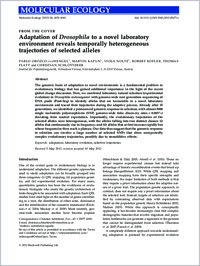Adaptation of Drosophila to a novel laboratory environment reveals temporally heterogeneous trajectories of selected alleles
- Orozco‐Terwengel, Pablo Institute of Population Genetics, Department of Biomedical Sciences, University of Veterinary Medicine Vienna, Austria
- Kapun, Martin Institute of Population Genetics, Department of Biomedical Sciences, University of Veterinary Medicine Vienna, Austria
- Nolte, Viola Institute of Population Genetics, Department of Biomedical Sciences, University of Veterinary Medicine Vienna, Austria
- Kofler, Robert Institute of Population Genetics, Department of Biomedical Sciences, University of Veterinary Medicine Vienna, Austria
- Flatt, Thomas Institute of Population Genetics, Department of Biomedical Sciences, University of Veterinary Medicine Vienna, Austria
- Schlötterer, Christian Institute of Population Genetics, Department of Biomedical Sciences, University of Veterinary Medicine Vienna, Austria
-
2012
Published in:
- Molecular Ecology. - 2012, vol. 21, no. 20, p. 4931–4941
English
The genomic basis of adaptation to novel environments is a fundamental problem in evolutionary biology that has gained additional importance in the light of the recent global change discussion. Here, we combined laboratory natural selection (experimental evolution) in Drosophila melanogaster with genome‐wide next generation sequencing of DNA pools (Pool‐Seq) to identify alleles that are favourable in a novel laboratory environment and traced their trajectories during the adaptive process. Already after 15 generations, we identified a pronounced genomic response to selection, with almost 5000 single nucleotide polymorphisms (SNP; genome‐wide false discovery rates < 0.005%) deviating from neutral expectation. Importantly, the evolutionary trajectories of the selected alleles were heterogeneous, with the alleles falling into two distinct classes: (i) alleles that continuously rise in frequency; and (ii) alleles that at first increase rapidly but whose frequencies then reach a plateau. Our data thus suggest that the genomic response to selection can involve a large number of selected SNPs that show unexpectedly complex evolutionary trajectories, possibly due to nonadditive effects.
- Faculty
- Faculté des sciences et de médecine
- Department
- Département de Biologie
- Language
-
- English
- Classification
- Biological sciences
- License
-
License undefined
- Identifiers
-
- RERO DOC 324279
- DOI 10.1111/j.1365-294X.2012.05673.x
- Persistent URL
- https://folia.unifr.ch/unifr/documents/307620
Statistics
Document views: 106
File downloads:
- pdf: 218
